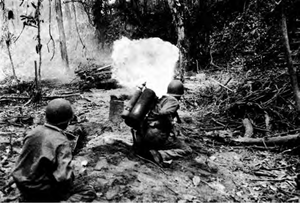
Back Lance-flammes M1A1 French Miotacz ognia M1A1 Polish M1 (lança-chamas) Portuguese M1 (огнемёт) Russian
| M1A1 Flamethrower | |
|---|---|
 M1A1 flamethrower being used against a Japanese bunker, March 1944. | |
| Type | Flamethrower |
| Place of origin | United States |
| Service history | |
| In service | 1941–1945 |
| Used by | United States Republic of China Philippine Commonwealth Philippines Vietcong |
| Wars | World War II |
| Production history | |
| Designer | US Army Chemical Warfare Service |
| Designed | 1940–41 |
| Manufacturer | State Factories |
| No. built | 13,886 (1,000 M1 & 12,886 M1A1) |
| Variants | E1, E1R1, M1, M1A1 |
| Specifications | |
| Mass | 70 lb (31.8 kg) |
| Crew | 2 |
| Rate of fire | ~half a gallon a second |
| Effective firing range | 65.5 ft (20 m) |
| Maximum firing range | 141 feet (43 m) |
| Feed system | 5 shots 1 (4.7 gal) Napalm infused gasoline tank (fuel) 1 Nitrogen tank (propellant) |
| Sights | None |
The M1 and M1A1 were portable flamethrowers developed by the United States during World War II. The M1 weighed 72 lb, had a range of 15 meters, and had a fuel tank capacity of five gallons. The improved M1A1 weighed less, at 65 lb, had a much longer range of 45 meters, had the same fuel tank capacity, and fired thickened fuel (napalm).
Development of the weapon began in July 1940. The first prototype had the designation of E1. The prototype was further refined into the E1R1 model, which resulted in the adopted M1 model in August 1941. These man-portable weapons saw little use in Europe. They were more common in the Pacific, where they were used extensively when attacking pillboxes and fortifications. The M1's unreliability and lack of developed tactics resulted in the failure of the first flamethrower attack on a Japanese fortification in December 1942. The M1 was gradually replaced by the M1A1 in 1943. The M1A1 was replaced by the M2 flamethrower later during the war.